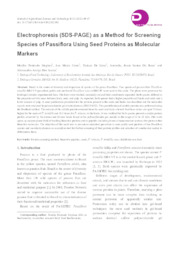Electrophoresis (SDS-PAGE) as a method for screening species of Passiflora using seed proteins as molecular markers.
Electrophoresis (SDS-PAGE) as a method for screening species of Passiflora using seed proteins as molecular markers.
Autoria: STEPHAN, M. P.; COSTA, A. M.; AZEVEDO, T. de L.; ROSA, J. S. da; SANTOS, A. A. dos
Resumo: Brazil is the center of diversity and dispersion of species of the genus Passiflora. Two species of passion fruit Passiflora tenuifila BRS VT (passiflora garlic) and another of Passiflora setacea BRS PC were used in this study. The plants were grown on the Embrapa Cerrados experimental farm. The fruits were washed, minimally cut and their constituents separated. Both species differed in the proportion of wet mass between husk, seed, and pulp. As expected, both species had a higher proportion of husks and seeds and a lower amount of pulp. A semi-purification procedure for the proteins present in the seeds and husks was described and the molecular aspects were analyzed by polyacrylamide gel electrophoresis (SDS-PAGE). The quantification of soluble proteins was performed using the Bradford method. The analysis of the soluble protein extracted from the seeds and husks showed that these values are up to 70 times higher for the seeds of P. tenuifila and 28.5 times for P. setacea, in the husks. It was verified that both species present a similar protein profile, observed by the intense and diverse bands found in the polyacrylamide gel, mainly in the range of 32 to 19 kDa. This work opens up an unexplored field of tracking bioactive proteins and/or peptides including forms of nanostructure systems that protect other bioactive molecules. The objective of this work was to present an analytical procedure to semi-purify seed proteins of two Passiflora species and use electrophoresis as an analysis tool for further screening of their protein profiles and selection of a molecular marker to differentiate them.
Ano de publicação: 2022
Tipo de publicação: Artigo de periódico
Unidade: Embrapa Agroindústria de Alimentos
Palavras-chave: Analytical methods, Bioactive compounds, Bioactive peptides, Casca, Eletroforese, Food technology, Fruits, Fruto, Maracujá, Mass distribution on fruit, Método de Análise, P setacea, P tenuifila, Passiflora, Passion fruits, Peptides, Peptídeo, Polpa, Polyacrylamide gel electrophoresis, Proteins, Proteína, Pulp, Purification methods, Purificação, Rastreamento, Seeds, Semente, Tecnologia de Alimento
Observações
1 - Por padrão são exibidas publicações dos últimos 20 anos. Para encontrar publicações mais antigas, configure o filtro ano de publicação, colocando o ano a partir do qual você deseja encontrar publicações. O filtro está na coluna da esquerda na busca acima.
2 - Para ler algumas publicações da Embrapa (apenas as que estão em formato ePub), é necessário ter, no celular ou computador, um desses softwares gratuitos. Sistemas Android: Google Play Livros; IOS: iBooks; Windows e Linux: software Calibre.
Acesse outras publicações
Acesse a Base de Dados da Pesquisa Agropecuária (BDPA) para consultar o acervo completo das bibliotecas da Embrapa.

